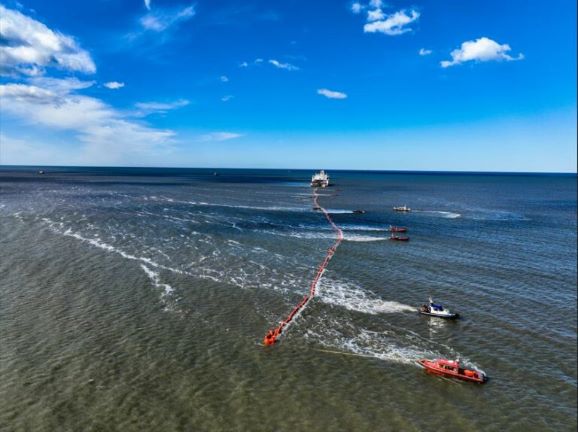Viking Link: World’s Largest Interconnector Days Away From Being Put Into Operation

By Melisa Cavcic
Danish transmission system operator (TSO) Energinet is getting ready to bring the Viking Link, which is said to be the world’s longest electricity interconnector, online by the end of the year, establishing a subsea cable connection between the UK and Denmark.
This will be done at a limited capacity, which is lower than previous expectations before the project can go into high gear once other pieces fall into place.
The Viking Link is expected to be put into operation on December 29, 2023, with an 800 MW import and export capacity of the new electricity connection between Denmark and England. Energinet explains that the full capacity of 1,400 MW cannot be offered to the electricity market from the start, as the West Jutland high-voltage grid has not yet been developed sufficiently.
The TSO elaborates that the existing electricity grid is at risk of overloading and resulting in a supply failure if the Viking Link high voltage direct current (HVDC) interconnector is given free rein to kick off its full capacity from day one, threatening the security of supply in the whole of Western Denmark. With this at the forefront, Energinet is working on market and operational measures, which can continuously increase the possibility of even more import and export of power across the North Sea.
Director of System Responsibility at Energinet, Klaus Winther commented: “Because the reinforcements of the high-voltage network in West Jutland are delayed, we have always known that it was a challenge to offer the full capacity of Viking Link to the electricity market from day one, but possible with a number of mitigating measures. The existing West Jutland electricity grid is simply not strong enough for all the power that, for example, Danish electricity producers want to send through Viking Link and sell in England, to reach the new connection.”
Viking Link’s full capacity coming later
When Viking Link was adopted in 2015, it happened at the same time as it was decided to expand the 400 kV high-voltage grid in West Jutland from Idomlund by Holstebro in the north to the Danish-German border in the south, thus, the projects were mutually dependent. However, the expansion of 400 kV connections along the west coast has run into several delays due to stricter requirements for environmental approvals.
Therefore, the spades on the new 400 kV connections have only just been put in the ground, and are not finished at the same time that Viking Link can be put into operation. If the capacity goes full throttle, in addition to the risk of overload and security of supply, it will also mean that large amounts of Danish electricity production from wind turbines, in particular, will have to be stopped for periods, as the electricity can easily be sold to England, but not come through the West Jutland grids on the way over there.
Winther added: “I am aware that electricity producers in particular would have liked to see that we could open for more exports than 800 MW from the start, but unfortunately we cannot do that without risking putting the Danish security of supply out of control.
“With 800 MW released to the electricity market, we are actually pushing the existing electricity grid in West Jutland more than we usually do and are getting closer to the limit of what we can squeeze out of the electricity grid without overloading it – precisely to ensure that as much as possible is available capacity in Viking Link.”
Energinet points out that the expansion of the 400 kV network along the west coast of Jutland will greatly increase the capacity of the western Danish high-voltage network and thus enable the full capacity of the Viking Link. The first part of the west coast connections from the German border to Endrup is scheduled to come online in the first quarter of 2025.
This announcement comes after Asso.subsea finished the burial and protection operations in September 2023 for the Viking Link interconnector. Prior to this, Prysmian installed the last section of the submarine cable for the project on July 13, establishing the connection from Revsing ved Vejen, through the Jutland soil, across the seabed, and to Bicker Fen in northern England.Once up and running at full tilt, Viking Link will operate at ±525 kV DC and will allow up to 1.4 GW of power to be transferred between the UK and Denmark, passing through the UK, Dutch, German and Danish waters, using single-core, mass-impregnated paper-insulated cables.
This project, stretching 765 km subsea and onshore connecting from Bicker Fen in Lincolnshire, UK, and Revsing in South Jutland, Denmark to enable clean energy to be shared, is a joint venture between National Grid Ventures, part of National Grid, and Denmark’s Energinet.
https://www.offshore-energy.biz



